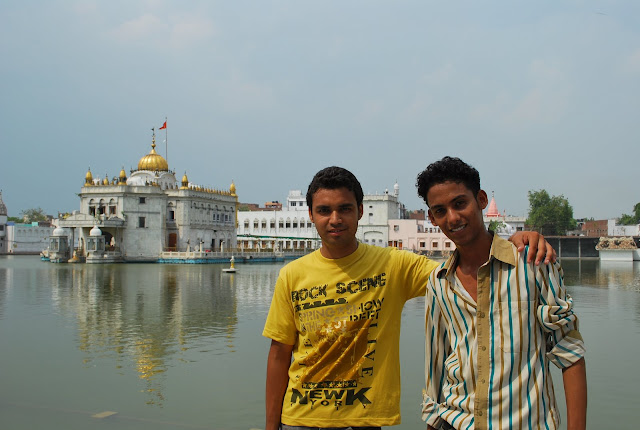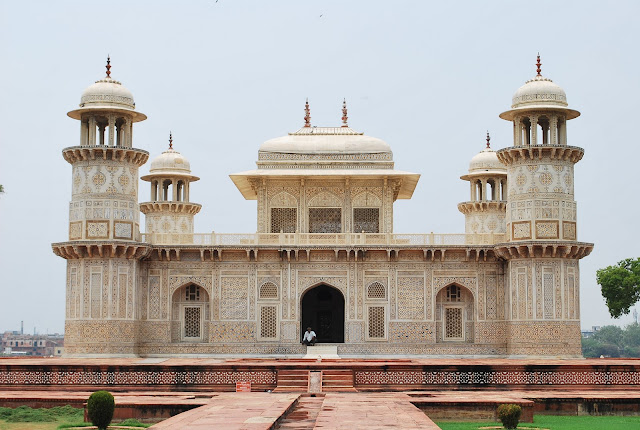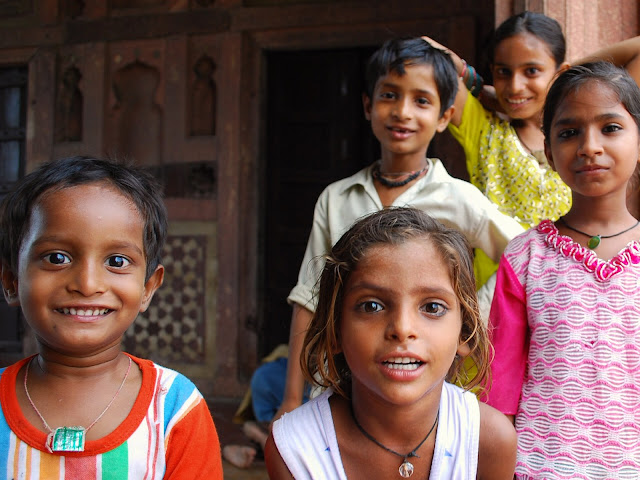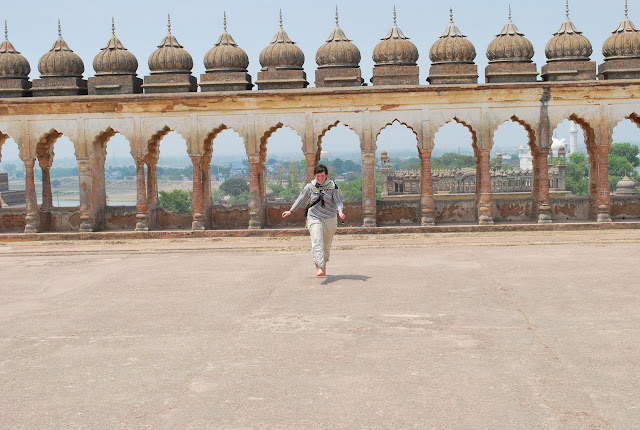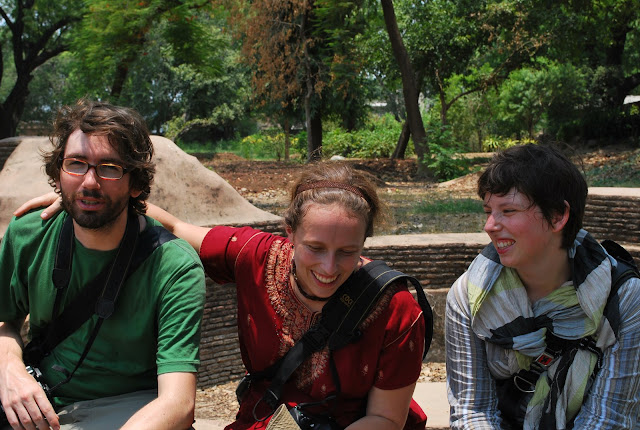The bus ride from Chandigarh to Delhi was much less thrilling and much more smelly than the bus trips we had taken around Himachal Pradesh. We had a rough six hour ride while completely squished, denied our change from the conductor (of course we didn't stop pestering him until we got it back, with the help of many kind Indians), harassed by drunk men, and assaulted by the smells that began wafting into the bus within miles of Delhi. We can't really describe the scents of Delhi without potentially offending our readership, but suffice it to say that in Delhi, you want to stay in the neighbourhoods that only smell as bad as urine.
Upon arrival in Delhi we were immediately reminded to be on guard for the touts and scams that are rampant here. We were misinformed about the location of the prepaid taxi stand at the bus depot by several different characters, and when we finally found it, even the workers at the stand - who are usually a bastion of decency among a hundred shady rickshaw drivers - seemed to be trying to take us for a ride! We eventually used our bargaining skills to get us to Majnu-ka-Tilla, a Tibetan neighbourhood in the north of the city, where a kind local showed us to a guesthouse. It was a lovely guesthouse and the area was much more charming than the traditional backpacker hangouts. We spent the next few days before our flight home sightseeing and shopping, and were always very glad to return to our neighbourhood for an overnight reprieve from the most intense parts of Delhi.
During our stay in Delhi we knew that we were heading home very soon, and we were generally exhausted and worn out on sightseeing. Also, Delhi is possibility the most intense place we visited, owing to the heat, traffic, touts, smells and astonishing poverty. We had mixed feelings about our approaching departure, so on the whole it was hard to give Delhi the attention and energy that it deserves. But, we tried to be responsible tourists and dragged ourselves around to the sights that we absolutely did not want to miss, and were always relieved to return to the air-conditioned guesthouse restaurant for our daily supper of momo soup and non-alcoholic apple beer.
Our transport of choice to get from our end of town into the action was the Delhi Metro, which is very new, clean, efficient and cheap. It was definitely the fastest way to get around despite having to go through security, including a metal detector, bag search and pat-down, each and every time we entered. There are also a ridiculous amount of armed police everywhere, standing behind makeshift sandbag bunkers in the modern subway corridors, automatic rifles constantly propped up, ready to go, and aimed at passersby.
In Old Delhi we visited Chandi Chowk and its bustling markets, where we shared the street with huge cows, monkeys and a staggering array of aromas. We walked to the Red Fort, built at the time of the Taj Mahal and the Agra Fort, and in modern times, a symbol of Indian independence. It was beautiful, but less impressive than the Agra Fort, and so it was difficult for us, in our travel-weary state, to muster much enthusiasm for it. Afterwards we walked a little ways to Jama Masjid, the largest mosque in India. As we were removing our shoes at the entrance, a small girl asked us for money, and the shoe-minder swiftly and shockingly struck the back of her head. We reprimanded him and headed for another entrance. There we had some disagreements with the staff, who seemed to be overcharging us, but finally we were able to gaze quickly at the large, beautiful domes and minarets surrounding a small, calm pool at the centre of a courtyard that can hold twenty-five thousand people.
Next we stopped in Pahar Ganj, the traditional backpacker district in New Delhi, for some shopping. Yann and Emilie showed us to a small shop overflowing with old wooden stamps of every shape and size, each one unique. We spent a very pleasant hour choosing some to take home with us, a nearly impossible task out of the thousands available, but they are some of our favourite souvenirs.
Since our flight to Amsterdam didn't leave until nearly 1 am, we were able to pack in a full schedule on our very last day in India, and we did one of the most important things on our trip. We visited in Gandhi Smriti, the memorial and museum built at the house were Gandhi spent his last days and where he was assassinated. It wasn't difficult to muster up the motivation to see this sight. The museum is full of information about Gandhi's life and philosophy, and the history of the Indian independence movement. We saw where he took his final steps and we visited the spot that he died. The most moving part was seeing his own bedroom, still set up as it was when he lived there, and the small collection of all of his worldly possessions, including his walking stick, eyeglasses and pocketwatch.
Perhaps we should be ashamed that what we did after visiting Gandhi's memorial was go shopping, but we have to recount the scams that occur whenever you try to take a shopping trip in Delhi. We were headed to the State Emporia, which are government-run and offer fair, fixed prices. The difficulty began as soon as we hired a rickshaw to take us there, and the driver offered an outrageously inflated price. We simply laughed and explained that we had been in India for many weeks, and he couldn't get away with such a distortion. He actually agreed to a very reasonable price, but only because he figured that he could drop us off at the wrong shop and earn commission. Little did the poor guy know that we had been there before and had suffered through this whole charade once already. He drove us to the wrong store and tried to assure us, over and over, that this was the right place. Finally we convinced him that the jig was up, and he drove us through the neighbourhood, past all of the false advertisements painted on the walls directing you the wrong way, "state emporium, this way!", and with a defeated demeanor, finally dropped us at the correct place.
At the guesthouse that night we savoured our last momo soup and prepared to catch our flight. Fittingly, on the taxi ride from the guesthouse, the song from Kambakkht Ishq came on and we reminisced by singing and dancing along one last time. This was the Bollywood movie that we saw in the theatre with Jitendra and Lucie's family, and the song plays everywhere, including on Indian Much Music, where we learned the accompanying dance moves. The taxi driver noticed our excitement when the song came on and when it ended, he surfed the stations to find it twice more for us before we got the to airport.
One 8.5 hour flight later we landed in Amsterdam, where we had a nine hour layover. We left the airport and took the very easy and efficient train downtown to Centraal Station, during which time we were in shock over the calm, clean, wide open spaces as compared to India.
 We enjoyed our time in Amsterdam very much, revelling in how everything was so easy and comfortable, but shocked at how much more expensive it was. We arrived downtown before 8 a.m. and there was almost no one in the streets, it was eerie. It was amazingly quiet compared to Delhi, with the exception of one very giggly, stumbling man who obviously hadn't made it to bed yet. We walked along the cobblestone streets and found a cafe just opening, and sat outside drinking lattes and admiring the wonderful architecture all around us.
We enjoyed our time in Amsterdam very much, revelling in how everything was so easy and comfortable, but shocked at how much more expensive it was. We arrived downtown before 8 a.m. and there was almost no one in the streets, it was eerie. It was amazingly quiet compared to Delhi, with the exception of one very giggly, stumbling man who obviously hadn't made it to bed yet. We walked along the cobblestone streets and found a cafe just opening, and sat outside drinking lattes and admiring the wonderful architecture all around us.
Although we were hungry, we were suffering from sticker shock and simply could not justify buying a full sit-down meal, so we walked to a bakery and had the most delicious kaas broodje, apfulflap and gevulden koeke that we have ever had. Antonia was very proud when she ordered and the counter person answered her back in Dutch, assuming that she was a local. After breakfast we jumped on a boat for a canal tour, where we fell in love with Amsterdam and its narrow townhouses, bicycle friendliness, houseboats, density, and amazing ability to preserve the beauty of the core of the city over hundreds of years.
We went for a stroll along the canals and unintentionally stumbled into the red light district, although it was really something to see, bustling away even before noon. We found Dam Square and bought fresh stroopwafel, fulfilling a life-long dream of Antonia's. We ended our mini Amsterdam tour, and our entire trip, with a Heineken on an outdoor patio before making our way back to the airport and catching our flight to Montreal.
































